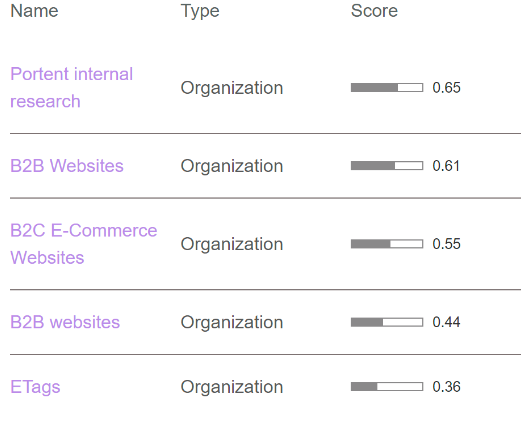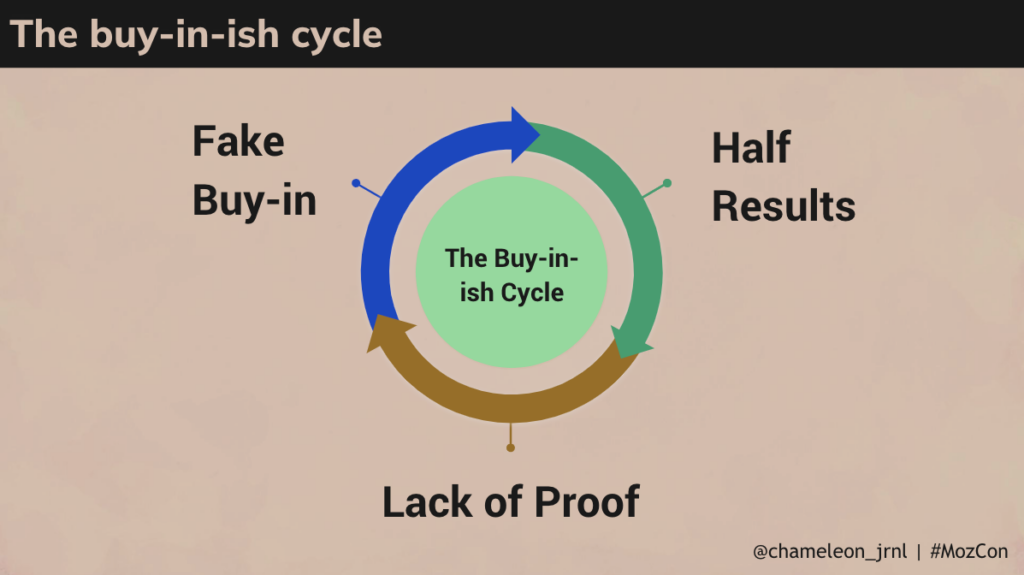Everyone was excited for a return to in-person for MozCon 2022, bringing back the impromptu conversations and networking we missed in recent years. Members of Portent’s organic team — Evan Hall, José Fausto Martinez, Leo Staten, Tammy Yu, and I — attended three days of exciting, innovative sessions for search marketers. Here are our favorite takeaways.

Moneyball is the Future of SEO
Presented by: Will Critchlow, SearchPilot
Recapped by Leo Staten
Will Critchlow explained the concept of applying advanced analytics to SEO using basketball as a framework. Recently, the game has changed. Teams are using data to gain a deeper understanding of the risk/reward of various shots.
Will stresses that testing is crucial to running successful campaigns in SEO, and an unsuccessful test is just as helpful in terms of insight as a winning one.

Will showed the crowd a heatmap (a la Hotjar) of the most commonly taken shots in basketball—both from last season and one from two decades ago. There were a few main areas of the court highlighted on both, although players take shots from fewer different locations in the contemporary game.
This is because they’ve determined analytically that the midrange shot—between the free throw line and the three-point line—is not a winning prospect. The three-pointer is only slightly less accurate and worth 50% more; therefore, the midrange shot is not worth it in terms of risk versus reward.

Will reminds us that we’ve never had access to so much data in so much granularity before and that he’s utterly confident that this data will continue to evolve the SEO landscape—just how complex data analytics have done for the game of basketball. Rigorously and frequently testing the site you’re working on is a crucial due diligence step and our responsibility as SEOs.
In Will’s analogy, layups are winning tests, and three-pointers are new site pages and content—riskier and less proven but potentially worth more and worthwhile. And, of course, their efficacy will be measured through—you guessed it—more testing.
My most actionable takeaway
Detailed analytical testing is not a luxury; it’s a responsibility and is crucial to creating and maintaining a competitive advantage.
More Than Pageviews: Evaluating Content Success & Correcting Content Failure
Presented by: Dana DiTomaso, Kickpoint
Recapped by Tammy Yu
Spoiler alert: content success is more than just pageviews. As SEOs and marketers, we focus on getting users to the page but rarely ensure our visitors are happy once they arrive.
Dana DiTomaso shared some questions to help you move towards a more meaningful evaluation of content success for your users and stakeholders:
1. How many of your visitors are tab hoarders?
The visitor is a tab hoarder if the navigation is reloaded in an existing tab. Using Simo Ahava’s web browser API, you can connect it to your Google Analytics and understand the percentage of pageviews that came from tab hoarders.
2. Do your reports include long-term or only short-term data?
For example, when reporting on top-performing pages, most marketers focus on top pages by month or quarter. Consider top pages since the website launched. By not including long-term data, “you’re missing out on the quiet performers who, day after day, are bringing in consistent traffic to your website.”
Another example Dana mentioned was to look at daily pageviews. Although a page may not be the top performing page by month or quarter, it may be a newer page that attracts more daily pageviews.
3. Did your users actually read your content?
When determining whether a user has read your content, what criteria do you consider?
Kickpoint has a content consumption Google Tag Manager recipe that considers word count, the time it takes to read that word count, and scroll tracking to an “endpoint” in the content. If a visitor’s time on the page exceeds reading time and they’ve scrolled to the endpoint, then the content was successfully consumed.
4. Could the visitor actually complete the action you wanted them to do?
Consider the goal for each page and where on the page users can actually take action.
For example, if the page’s goal is for users to sign up for a service, consider whether there’s even a CTA on the page? Is the CTA buried?
5. What is the point of a page?
When building out reports, only report on the relevant pages. Otherwise, it’s just noise.
For every page on the site, consider categorizing each page by the job to be done (JTBD). Examples:
- Navigation
- Content Consumption
- Contact
For example, don’t include the homepage if the JTBD is to fill out a contact form. The homepage is supposed to help users navigate to a different page; it’s not a page meant to be read (content consumption) or used for contact form fills. Including a homepage in a contact form fills report will likely show a much lower conversion rate.
My most actionable takeaway
Consider the goals most important to your business and focus only on that—anything else is just noise and has the potential to cause doubt and distractions.
Advanced On-Page Optimization
Presented by: Chris Long, Go Fish Digital
Recapped by Evan Hall
Chris Long addressed a problem every SEO has encountered at some point: how do you improve the rankings for a page after you’ve reviewed it multiple times and placed keywords everywhere appropriate? His answer hit upon several topics other presenters brought up.
Google announced its Knowledge Graph back in 2012, and its motto for the technology was “things, not strings.” We have to take this seriously if we’re going to keep up with future algorithm updates.
So which things, or “entities,” do we need to talk about on the page? Chris recommended using the IBM Watson Alchemy API to analyze the text of competing pages. There are similar tools out there. Lily Ray recommended using Diffbot. We built a front-end interface for Google’s Cloud Natural Language API that we use internally at Portent. So far, there isn’t a ready-made commercial tool suitable for marketers that does this.

They all perform the same function: extract entities of text. Using these, we can extract the entities from the text of our competitors’ pages and see which ones we need to add to ours – a similar process to doing a content gap analysis task by hand.
We can also improve the content of a page by building more expertise into it. Many queries deserve an expert opinion, so find an expert to write it, display that author’s expertise in an author bio, and have that author write about related topics on the site and elsewhere. This is a pretty standard recommendation now.
Why have an expert write content though? Remember the earlier recommendation to fill entity gaps? An expert will naturally talk about the right entities in their content, and they would probably know how a list of missing entities should fit together.
Another thing an expert will naturally bring to content is extra information. Merely closing the entity or topic gap with competitors will make Google’s results very repetitive. Google filed a patent for computing information gain scores, which indicates they are looking into the problem. An expert author can accomplish two things to help you rank: fully address the user’s query and provide additional information a non-expert wouldn’t have.
That additional information could be in the form of original research, cited sources, and links to relevant content.
Chris also talked about how vital fresh information is. Travis McKnight, our Senior Content Strategist, recently published a study on the ranking impact of doing freshness updates to content. Both Travis and Chris found positive results from updating content.
My most actionable takeaway
Chris suggests doing one content freshness update based on missing entities by an expert as a test and evaluating the results. Then you’ll have enough information to decide whether it’s worth continuing.
Things I Learned from Sales Teams that Every SEO Should Know
Presented by: Petra Kis-Heczegh, Yext
Recapped by José Fausto Martinez
Navigating “buy-in-land” is difficult, but Petra’s advice helps SEOs take control over that adventure. Petra’s presentation defines an Organizational Maturity Graph for SEO as multidimensional because it requires growing and nurturing.
My favorite part is what she called the “buy-in-ish cycle,” made up of fake buy-in, half results, and lack of proof. This cycle applies to both agencies and in-house teams. In this presentation, I learned how to flip that cycle and convert it into a “bought-in cycle” of real buy-in, results that meet expectations, and success stories.

Here’s what I learned on how to get a bought-in cycle.
- Be skeptical of a “yes” because it can be said without commitment. Go for the “yes” that includes commitment.
- Remember that decision-makers are human. They are not strictly rational, so as SEOs, we need to focus on making them feel comfortable about the uncomfortable.
- Learn to tell a good story that focuses on the outcome. You want to speak the stakeholder’s language.
- When prioritizing, include probability and remember that “if everything is important, then nothing is.”
My most actionable takeaway
Always ask questions that clarify objections because it will also help get your audience involved. Having them involved is one way of many to create a “bought-in-cycle.”
Why Real Expertise is the Most Important Ranking Factor of Them All
Presented by: Lily Ray, Amsive Digitial
Recapped by Kat Shereko
EAT ranking factors – Expertise, Authoritativeness, and Trust – have been top of mind for many SEOs. And while, when done well, all three factors can help bolster organic rankings, Lily Ray argues that “Expertise” is the ranking factor we need to pay close attention to.
In the early days, addressing expertise was as simple as creating an author bio or including an in-text mention that someone with a Ph.D. reviewed the content. Today, Google knows better. It uses entities to make sense of the author’s bio, draw connections, and determine if the information is real or fake.
Curious to know how Google is interpreting your author bios or even your ‘About Us’ page? Lily recommends checking out Diffbot Natural Language API. Here’s an example of what this looks like with my bio:

So what do websites with stellar “expertise” have in common? Glad you asked! Here are some of Lily’s findings from her studies.
Winning ‘Expertise’ websites:
- focus on one niche
- have robust “About Me/Us” pages
- write content in the first person
- are transparent about their authors
- back up expertise with evidence (e.g., data, research, etc.)
- are linked to as a primary source
- offer objective advice without pushing their products
- demonstrate proof when product testing (e.g., detailed product reviews, images/video content)
Examples of websites that show their expertise:
- Smith’s Pest Management – pest control service
- Mind Body Green – health and wellness
- Renee Roaming – travel blog
- Carolina Honeybees – personal bee blog
- RetroFoam – home insulation service
- Bob Vila – home improvement blog
My most actionable takeaway
Google uses EAT to evaluate content, authors, and websites. To achieve optimal SEO performance, adding “EAT elements,” such as author bios, is not enough. If you want your site to win, take the time to develop content that displays your expertise in the subject matter.
Final Thoughts
That’s a wrap! Those were our top takeaways from MozCon 2022. Our team is invigorated and excited to apply the new skills and ideas they learned to our client projects.









